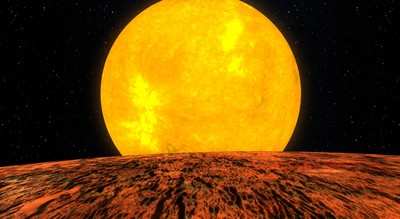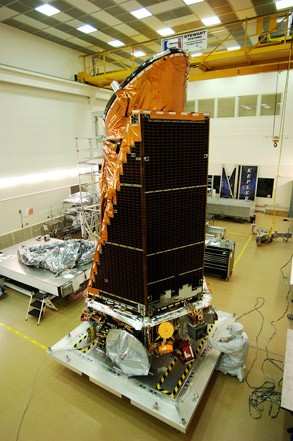But It's Not Exactly A Vacation Spot ... Keplar-10b Not In The
'Habitable Zone'
NASA's Kepler mission confirmed the discovery of its first rocky
planet, named Kepler-10b. Measuring 1.4 times the size of Earth, it
is the smallest planet ever discovered outside our solar system.
The discovery of this planet, called an exoplanet, is based on more
than eight months of data collected by the spacecraft from May 2009
to early January 2010.

NASA Artist's Concept Of Kepler-10b With Host Star In The
Background
"All of Kepler's best capabilities have converged to yield the
first solid evidence of a rocky planet orbiting a star other than
our sun," said Natalie Batalha, Kepler's deputy science team lead
at NASA's Ames Research Center in Moffett Field, CA, and primary
author of a paper on the discovery accepted by the Astrophysical
Journal. "The Kepler team made a commitment in 2010 about finding
the telltale signatures of small planets in the data, and it's
beginning to pay off."
Kepler's ultra-precise photometer measures the tiny decrease in
a star's brightness that occurs when a planet crosses in front of
it. The size of the planet can be derived from these periodic dips
in brightness. The distance between the planet and the star is
calculated by measuring the time between successive dips as the
planet orbits the star.
Kepler is the first NASA mission capable of finding Earth-size
planets in or near the habitable zone, the region in a planetary
system where liquid water can exist on the planet's surface.
However, since it orbits once every 0.84 days, Kepler-10b is more
than 20 times closer to its star than Mercury is to our sun and not
in the habitable zone.

Kepler-10 was the first star identified that could potentially
harbor a small transiting planet, placing it at the top of the list
for ground-based observations with the W.M. Keck Observatory
10-meter telescope in Hawaii. Scientists waiting for a signal to
confirm Kepler-10b as a planet were not disappointed. Keck was able
to measure tiny changes in the star's spectrum, called Doppler
shifts, caused by the telltale tug exerted by the orbiting planet
on the star.
"The discovery of Kepler 10-b is a significant milestone in the
search for planets similar to our own," said Douglas Hudgins,
Kepler program scientist at NASA Headquarters in Washington.
"Although this planet is not in the habitable zone, the exciting
find showcases the kinds of discoveries made possible by the
mission and the promise of many more to come."
Knowledge of the planet is only as good as the knowledge of the
star it orbits. Because Kepler-10 is one of the brighter stars
being targeted by Kepler, scientists were able to detect
high-frequency variations in the star's brightness generated by
stellar oscillations, or starquakes. This analysis allowed
scientists to pin down Kepler-10b's properties.
There is a clear signal in the data arising from light waves
that travel within the interior of the star. Kepler Asteroseismic
Science Consortium scientists use the information to better
understand the star, just as earthquakes are used to learn about
Earth's interior structure. As a result of this analysis, Kepler-10
is one of the most well-characterized planet-hosting stars in the
universe.

Kepler Telescope Prior To Launch
That's good news for the team studying Kepler-10b. Accurate
stellar properties yield accurate planet properties. In the case of
Kepler-10b, the picture that emerges is of a rocky planet with a
mass 4.6 times that of Earth and with an average density of 8.8
grams per cubic centimeter -- similar to that of an iron
dumbbell.
Ames manages Kepler's ground system development, mission
operations and science data analysis. NASA's Jet Propulsion
Laboratory in Pasadena, Calif., managed Kepler mission development.
Ball Aerospace and Technologies Corp. in Boulder, CO, developed the
Kepler flight system and supports mission operations with the
Laboratory for Atmospheric and Space Physics at the University of
Colorado in Boulder. The Space Telescope Science Institute in
Baltimore archives, hosts and distributes the Kepler science
data.
 ANN's Daily Aero-Term (12.13.25): Light Gun
ANN's Daily Aero-Term (12.13.25): Light Gun Aero-News: Quote of the Day (12.13.25)
Aero-News: Quote of the Day (12.13.25) NTSB Final Report: Gippsland GA-8
NTSB Final Report: Gippsland GA-8 Classic Aero-TV: Historically Unique -- Marlin Horst's Exquisite Fairchild 71
Classic Aero-TV: Historically Unique -- Marlin Horst's Exquisite Fairchild 71 Airborne 12.12.25: Global 8000, Korea Pilot Honors, AV-30 Update
Airborne 12.12.25: Global 8000, Korea Pilot Honors, AV-30 Update





